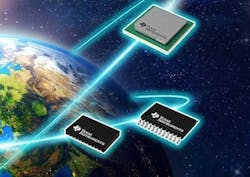Members can download this article in PDF format.
Operating in space requires that the electronic components in spacecraft must withstand a wide variety of challenges, ranging from hundreds of degrees of temperature change to massive amounts of radiation. On the moon, for example, during a lunar day and night, the temperature on the surface can vary from around −200 to 200°C.
Outside the protective cover of the Earth’s atmosphere, the solar system is filled with radiation that can damage electronic devices. The effects range from performance degradation to complete functional failure.
Given these challenges there's a clear requirement for rigorous standards to ensure component reliability. Manufacturers of ceramic-packaged space electronics have released ICs to the market under a qualification known as Qualified Manufacturers List (QML) Class V. The QML spec provides assurance that parts will operate as intended in the harsh environments of space.
Unfortunately, the ceramic packaging that's been used for space applications in the past has limited how small systems can get.
Achieving QML Class P
Because of this, TI, with more than six decades of experience in creating solutions for space, worked with NASA and other industry specialists to lead development of a new plastic packaging standard for space electronics, called Qualified Manufacturers List Class P (QML Class P) that would allow space designers to meet operating requirements while maintaining high radiation resistance. QML Class P is similar to Class V, but in a plastic package rather than the traditional ceramic packaging.
Until QML Class P, there had been no standardized, radiation-hardened equivalent for plastic packaging.
Transforming Space Electronics
With QML Class P parts, engineers can reduce the size of the plastic packages compared to the ceramic package by up to 50%, which means smaller bond wires are inside the part itself. Those bond wires actually add to the resistance and inductance of the device as well. Reducing the resistance based on just the bond wires can improve the efficiency of the total solution.
The difference between QML-V and QML-P really comes down to the packaging structure. The QML-V products comprise a ceramic substrate. They have an open cavity inside where the semiconductor die is placed and wired to the pins. Then the pins bring the electrical signals out to the circuit board.
Look at the QML-P-type plastic packages and you will not see an air cavity. The part is completely encapsulated in a mold compound that’s a plastic epoxy.
The QML Class P standard enables the use of radiation-hardened plastic packaging for power-management, processor, communications, and high-speed integrated circuits (ICs) in satellites and other spacecraft. It also enables more advanced computing in space, such as how satellites and other spacecraft can autonomously process data, and makes decisions in orbit as opposed to beaming data back down to Earth.
TI’s QML Class P certified portfolio offers solutions across the entire spacecraft electrical power system (EPS), from solar panels to point-of-load power supplies. With these devices, engineers are able to increase the efficiency of the power supply while reducing the size of the overall package, resulting in much higher power density.
Space operators can now easily transition to a radiation-hardened design with QML Class P parts without any hardware change given its pin-to-pin compatibility (TI still offers the traditional radiation-hardened ceramic packaging; radiation testing is exactly the same between the ceramic-packaged parts and the plastic-packaged parts.)
Outgassing
Earlier forms of plastic packaging have been vulnerable to a process known as outgassing. Plastics, glues, and adhesives can and do outgas.
Outgassing describes a process when the harsh temperature and vacuum conditions of space vaporize organic compounds, which can deposit onto electronics causing them to fail. Using ceramic rather than plastic components eliminates this problem in electronics. Contamination from outgassing, venting, leaks, and thruster firing can degrade and modify the external surfaces of the spacecraft.
Depending on the severity, the effects of outgassing can interrupt or completely end missions. Outgassing and radiation-based degradation puts strict limits on materials that can be used in space.
High levels of contamination on surfaces also may contribute to electrostatic discharge—a buildup of energy from the space environment, that could damage the devices. Discharges as high as 20,000 V have been known to occur on satellites in geosynchronous orbits.
Engineer the Next Frontier with TI's Space Products
In TI’s product guide, you will find the latest radiation-tolerant and radiation-hardened products, including QML Class P-approved products. The breadth of TI’s space portfolio provides a full signal-chain solution. It includes the smallest RHA point-of-load power solutions, fast discrete SerDes, and high-performance data converters.

